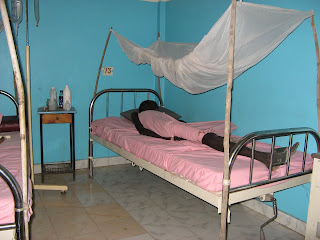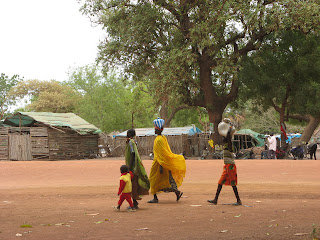In the last blogpost, I gave a brief history of South Sudan up to the date of independence – July 9, 2011. In this post, I would like to give some background information on some of the bigger issues the new country faces as it moves into the future.
Issue 1: South Sudan is one of Africa’s least developed countries.
Health and education statistics show there is much work to be done. Tropical diseases and diseases resulting from unclean water and poor sanitation are common: malaria, pneumonia, diarrhea, tuberculosis, acute respiratory disease, hepatitis, HIV/AIDS, guinea worm, meningitis, measles, typhoid fever, cholera, and many others. Water-borne diseases are common because boreholes and open, unprotected wells are the main sources of drinking water. Sanitation is largely absent and few people have access to toilet facilities. Chronic malnutrition, which weakens resistance to disease, is common. There is not enough food and people are very dependent on food aid.
Infant and maternal mortality rates are among the highest in the world. In South Sudan, one in ten children die before their first birthday, and one in seven dies before their fifth birthday. One out of seven women who become pregnant will probably die from pregnancy-related causes. There are simply very few medical facilities and trained medical professionals. 75% of the people do not have access to even basic health care. Many South Sudanese must walk for days in order to reach a clinic. Most of the medical care that is available in South Sudan is provided by international aid groups.
Government officials estimate that only 27% of adults can read. Among women, the figure is even lower – 84% of South Sudanese women cannot read or write. In nine of the ten South Sudanese states, less than 5% of children finish primary school. Only 6% of girls who start school ever finish.
Issue 2: The oil issue.
Sudan and South Sudan produce 500,000 barrels of oil daily, and 75% of it comes from the South. However the refineries that refine the oil and the pipelines that carry it to shipping ports on the Red Sea are in the north. Since the Peace Agreement in 2005, oil revenue has been split equally between northern and southern Sudan, but there has been no agreement on how to split oil revenues after southern independence.
(North) Sudanese president Omar al-Bashir threatened to shut down the pipelines carrying South Sudan’s oil if an agreement on sharing oil revenue was not reached before independence on July 9. So far that has not happened, but if oil exports are discontinued, the southern economy will collapse. Almost all the government income of South Sudan comes from oil exports – a whopping 98%. The government will not be able to pay its soldiers, and peace will be threatened. A new pipeline has been proposed that would run from Juba to Lamu, Kenya, bypassing northern Sudan, but it would take a few years to build. So it is likely that the south will pay to continue using the pipeline through the north for some time to come.
In any event, South Sudan does not have an infinite reserve of oil, and unless new deposits are discovered, it is likely that supplies will run out in 20 to 30 years. In the long term, the South will need to diversify its economy away from oil. Two areas that look promising are agriculture and minerals.
Issue 3: Border disputes and conflicts with Sudan.
There are several areas in which an agreement has not been reached on where to draw the border between Sudan and South Sudan. The main dispute is over the region of Abyei, which is an oil-producing region and a valuable source of water for the north during the dry season. Conflict over Abyei arose because two different ethnic groups claim the region: the Dinka Ngok, a southern group, and the Misseriya, who are northern Sudanese nomads accustomed to moving through the area each year in search of grazing land for their cattle. Tensions grew when the referendum vote which took place in the rest of southern Sudan in January of 2011 did not take place in Abyei because the two sides were unable to agree on whether the nomadic Misseriya should be able to vote. Fighting broke out in Abyei in May, a few weeks before southern independence, and large parts of Abyei town were burned to the ground.
Though not the subject of a border dispute, another region of conflict is in the Nuba Mountains, which lie in (northern) Sudan’s South Kordofan state. The Nuba people who live there are black and largely Christian who feel they have more in common with people in South Sudan than with the Arab-dominated North, and would prefer to be part of South Sudan. Many Nuba fought with southern forces during the civil war, and the tribe is now facing retaliation from the northern army, which has dropped bombs on areas they inhabit. Aid workers there say ethnic Nubans are also being targeted by northern and Arab militias. The Nuban people are retreating deeper into the mountains in an attempt to escape the persecution.
Issue 4: Rebel forces inside South Sudan.
There are at least a half-dozen rebel forces inside South Sudan that are opposed to the South Sudan government, which is largely controlled by members of the SPLM (Sudan People’s Liberation Movement). The SPLA/SPLM was the most powerful insurgent group during the fight for independence from the north. The largest rebel group is the South Sudan Liberation Army (SSLA), led by Peter Gadet. The SSLA says it is fighting corruption within the government, lack of development in the country, and domination by the Dinka ethnic group. They are concerned that the new government is spending more money on the army than on health and education, and that members of the Dinka tribe hold a majority of positions in the new government.
The South Sudanese government claims that these rebel groups are being funded and supplied by the (northern) Sudanese government in an attempt to weaken the new government of South Sudan. It is a fact that the Khartoum government did fund rival groups during the long civil war in order to weaken the SPLA. The rebel groups have engaged in fights with the South Sudanese army, and represent a threat to peace and stability in the country.















